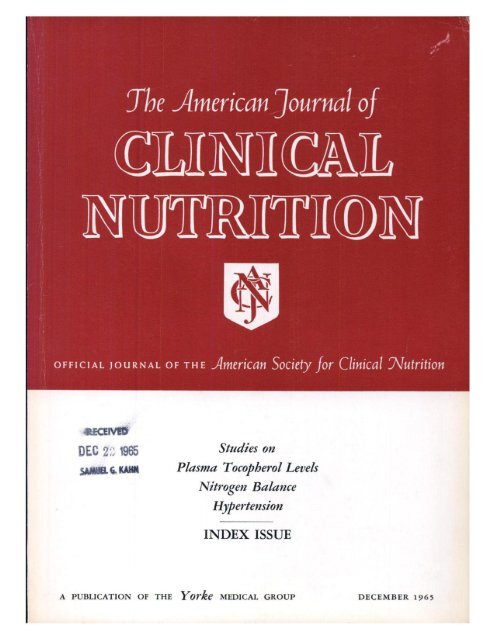Nutritional priorities to support GLP-1 therapy for obesity: a joint Advisory from the American College of Lifestyle Medicine, the American Society for Nutrition, the Obesity Medicine Association, and The Obesity Society
IF 6.5
1区 医学
Q1 NUTRITION & DIETETICS
引用次数: 0
Abstract
Background
Glucagon-like peptide 1 receptor agonists and combination medications (hereafter collectively referred to as GLP-1s) are shifting the treatment landscape for obesity. However, real-world challenges and limited clinician and public knowledge on nutritional and lifestyle interventions can limit GLP-1 efficacy, equitable results, and cost-effectiveness.
Objectives
We aimed to identify pragmatic priorities for nutrition and other lifestyle interventions relevant to GLP-1 treatment of obesity for the practicing clinician.
Methods
An expert group comprising multiple clinical and research disciplines appraised the scientific literature, informed by expert knowledge and clinical experience, to identify and summarize relevant topics, priorities, and emerging directions.
Results
GLP-1s reduce body weight by 5% to 18% in trials, with modestly lower effects in real-world analyses, and multiple demonstrated clinical benefits. Challenges include side effects, especially gastrointestinal; nutritional deficiencies due to calorie reduction; muscle and bone loss; low long-term adherence with subsequent weight regain; and high costs with resulting low cost-effectiveness. Numerous practice guidelines recommend multicomponent, evidence-based nutritional and behavioral therapy for adults with obesity, but use of such therapies with GLP-1s is not widespread. Priorities to address this include: (a) patient-centered initiation of GLP-1s, including goals for weight reduction and health; (b) baseline screening, including usual dietary habits, emotional triggers, disordered eating, and relevant medical conditions; (c) comprehensive exam including muscle strength, function, and body composition assessment; (d) social determinants of health screening; (e) and lifestyle assessment including aerobic activity, strength training, sleep, mental stress, substance use, and social connections. During GLP-1 use, nutritional and medical management of gastrointestinal side effects is critical, as is navigating altered dietary preferences and intakes, preventing nutrient deficiencies, preserving muscle and bone mass through resistance training and appropriate diet, and complementary lifestyle interventions. Supportive strategies include group-based visits, registered dietitian nutritionist counseling, telehealth and digital platforms, and Food is Medicine interventions. Drug access, food and nutrition insecurity, and nutrition and culinary knowledge influence equitable obesity management with GLP-1s. Emerging areas for more study include dietary modulation of endogenous GLP-1, strategies to improve compliance, nutritional priorities for weight maintenance post-cessation, combination or staged intensive lifestyle management, and diagnostic criteria for clinical obesity.
Conclusions
Evidence-based nutritional and lifestyle strategies play a pivotal role to address key challenges around GLP-1 treatment of obesity, making clinicians more effective in advancing their patients’ health.
支持GLP-1治疗肥胖的营养优先:美国生活方式医学院、美国营养学会、肥胖医学协会和肥胖学会的联合咨询。
背景:胰高血糖素样肽1受体激动剂和联合用药(以下统称为glp -1)正在改变肥胖的治疗前景。然而,现实世界的挑战和有限的临床医生和公众对营养和生活方式干预的认识限制了GLP-1的疗效、公平的结果和成本效益。目的:我们旨在为临床医生确定与GLP-1治疗肥胖相关的营养和其他生活方式干预的实际优先事项。方法:由多个临床和研究学科组成的专家小组,根据专家知识和临床经验,对科学文献进行评估,确定和总结相关主题、优先事项和新兴方向。结果:glp -1在试验中减轻体重5%至18%,在实际分析中效果较低,并有多种临床益处。挑战包括副作用,尤其是胃肠道;热量减少导致的营养缺乏;肌肉和骨质流失;长期依从性低,随后体重反弹;而高成本带来的低成本效益。许多实践指南建议对成人肥胖患者采用多组分、循证营养和行为疗法,但这种治疗glp -1的方法并不普遍。解决这一问题的优先事项包括:(a)以患者为中心启动glp -1,包括减肥和健康目标;(b)基线筛查,包括通常的饮食习惯、情绪触发因素、饮食失调和相关医疗状况;(c)综合检查,包括肌力、功能和身体成分评估;(d)健康检查的社会决定因素;(e)生活方式评估,包括有氧运动、力量训练、睡眠、精神压力、物质使用和社会关系。在使用GLP-1期间,胃肠道副作用的营养和医疗管理至关重要,正如改变饮食偏好和摄入量,预防营养缺乏,通过阻力训练和适当的饮食以及补充的生活方式干预来保持肌肉和骨量一样。支持性策略包括团体访问、注册营养师和营养师咨询、远程医疗和数字平台以及食品即医学干预措施。药物获取、食物和营养不安全以及营养和烹饪知识影响glp -1的公平肥胖管理。更多研究的新兴领域包括内源性GLP-1的饮食调节,提高依从性的策略,戒烟后体重维持的营养重点,联合或分阶段强化生活方式管理,以及临床肥胖的诊断标准。结论:基于证据的营养和生活方式策略在解决GLP-1治疗肥胖的关键挑战方面发挥着关键作用,使临床医生更有效地促进患者的健康。
本文章由计算机程序翻译,如有差异,请以英文原文为准。
求助全文
约1分钟内获得全文
求助全文
来源期刊
CiteScore
12.40
自引率
4.20%
发文量
332
审稿时长
38 days
期刊介绍:
American Journal of Clinical Nutrition is recognized as the most highly rated peer-reviewed, primary research journal in nutrition and dietetics.It focuses on publishing the latest research on various topics in nutrition, including but not limited to obesity, vitamins and minerals, nutrition and disease, and energy metabolism.
Purpose:
The purpose of AJCN is to:
Publish original research studies relevant to human and clinical nutrition.
Consider well-controlled clinical studies describing scientific mechanisms, efficacy, and safety of dietary interventions in the context of disease prevention or health benefits.
Encourage public health and epidemiologic studies relevant to human nutrition.
Promote innovative investigations of nutritional questions employing epigenetic, genomic, proteomic, and metabolomic approaches.
Include solicited editorials, book reviews, solicited or unsolicited review articles, invited controversy position papers, and letters to the Editor related to prior AJCN articles.
Peer Review Process:
All submitted material with scientific content undergoes peer review by the Editors or their designees before acceptance for publication.

 求助内容:
求助内容: 应助结果提醒方式:
应助结果提醒方式:


